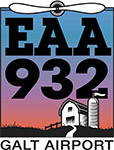Obtain An IFR clearance on the ground
When departing from a non-towered airport, pilots have two options for obtaining IFR clearances on the ground.
At some airports you may be able to reach ATC on the ground using the radio frequency listed for clearance delivery or approach control.
Another option is to call clearance delivery directly on your phone. You can find the phone number for the overlying Air Route Traffic Control Center (ARTCC) listed in the Chart Supplement in the communications section under “Clearance Delivery Phone.”
If you use the ForeFlight Mobile app, the phone number is listed under AIRPORTS, the “Info” tab, subcategory “Frequencies” then “Clearance.” For example, at Galt Airport (10C), IFR clearances are provided by Chicago Approach at (847) 289-0926. If you are using ForeFlight on an iPhone, you can simply tap on the number to initiate a phone call to that facility.
These days you can Bluetooth your headset to your phone and make the call from your airplane when you are ready to depart. The advantage of getting your clearance over the phone is that it will likely be better reception than the radio and you won’t be tying up the frequency when you need to ask the controller to spell out all the unfamiliar waypoints!
Pick Up Your Clearance In the Air
When weather conditions allow, you can depart your airport VFR and pick up your IFR clearance once airborne, but there are several caveats with this method. First, the weather must be good enough for you to maintain VFR visibility and cloud clearances the entire time until you receive your IFR clearance.
Another consideration is that in the air you have to work with approach controllers over the radio. If they are busy it is very inconvenient for you to tie up the frequency by picking up your full clearance. This can be disruptive to other pilots.
Sometimes it can be difficult to reach approach either due to poor radio reception or because they are swamped, which means you could experience a considerable delay in obtaining your IFR clearance. You might have to fly quite a distance along your route before you receive your clearance.
This brings up another issue. When you file your flight plan it is stored in the system by the departure airport air traffic controlling agency and is not available to controllers working outside of those boundaries. This means that if you cross that boundary before you pick up your clearance, the controller you eventually talk to will not be able to locate your flight plan in their system.
If you are flying single pilot, and heaven forbid, without an autopilot, you might already be overloaded with maintaining VFR, managing turbulence, navigating around complex airspace, and other piloting duties. On top of all that it can be quite challenging to copy down a long, complicated clearance, especially if it is not “as filed.”
What about Flight Service?
Prior to June 2019, the usual method to pick up an IFR clearance from a non-towered airport was to call Leidos Flight Service on the telephone or over the radio. The FSS would relay clearance information between the ARTCC or approach control and pilots. The FAA discontinued this service, except for pilots requesting clearances from Flight Service over Remote Communications Outlets (RCO), Ground Communication Outlets (GCO), or from locations in Alaska.
The publication of phone numbers for direct contact with approach control facilities has replaced the need to call flight service to obtain or cancel IFR clearances.
If you don’t happen to have a chart supplement or ForeFlight with you, Flight Service can still provide you with the name and phone number of the appropriate ATC facility to contact.
It should be noted that many older instrument flying books and a great number of online articles still still direct pilots to go through Flight Service for clearances. That information is out of date.
Beth Rehm, CFII

